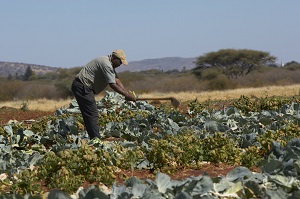
Uranium One looks to contributing to long-term prosperity and sustainable development

In a recent in-house interview Kirill Egorov-Kirillov, Director of Mines at Uranium One and Director of Headspring Investment zooms in on the company’s operations and strategies going forward.
As we have heard, Uranium One has recently opened an office in Leonardville. What does it mean for the company, its activities, and the local community?
The opening of the office is an important step in developing the company’s operations and building valuable partnerships aimed at improving life throughout the county. It demonstrates our intention to do the project and our long-term plans to cooperate with the region and the country. We aim to be a trusted partner that not only works alongside and invests in business development, but also creates many projects that benefit the Namibian society. Uranium One has already spent over N$3.8 million on social projects. These include the purchase and repair of vehicles for police and medical services, improvement of the city park, which has become a favorite place for recreation and events for adults and children, supply of food to the city school, and the construction of a school kitchen. And that’s just the beginning.
In 2023 you received an environmental certificate for the field laboratory – why is this important for the project?
Obtaining an Environmental Clearance Certificate (ECC) for our laboratory once again shows a high level of confidence in our company on the part of the regulatory authorities. We, in turn, confidently demonstrate that we compulsorily carry out all necessary procedures with regard to environmental impact assessment and comply with all laws, rules, and regulations of Namibia. The use of our own laboratory during fieldwork is certainly very time-saving, costsaving and in general significantly increases the efficiency of project implementation. We will be able to get the results of groundwater and surface condition assessment as quickly as possible. This is fully in line with the basic principles of our work: safety and efficiency.
The release of the ECC was a very positive step for us and gave hope to those communities that are looking forward to the benefits that will come from planned mining.
First of all, it is a step forward to create new jobs. We plan to attract local residents to work in the laboratory by providing the necessary training for specialists. In the future, this will help them to be in demand and have well-paid jobs.
How is it going with obtaining other certificates and permits for the project?
As I said, we are operating strictly within Namibian law, so we have submitted an application to the Ministry of Environment Forestry and Tourism. It is currently under review.
Following recent legislative changes and the coming into force of the Water Resources Management Act, Act 11 of 2013 (the “Act”) by the Minister of Agriculture, Water Resources and Land Reform dated 29 August 2023, the Company has decided to withdraw its application to the High Court of Namibia, for judicial review of the decision of the Ministry of Agriculture, Water Resources, Land Reform to refuse a permit for exploratory drilling. Although the law has been in place since 2013, its recent enactment has made significant changes to the legal framework governing such activities.
We are also open to dialog and continue to consult with all stakeholders to clarify any issues related to the project and reach mutual understanding. We are confident that the company will be given a fair opportunity to conduct field trials that will confirm the safety of the extraction method, particularly in relation to underground water sources vital to local communities.
What strategies does Uranium One employ to monitor and mitigate the environmental impact of its mining activities in Namibia and how does the company collaborate with relevant agencies and organizations in this regard?
We draw on our extensive experience with uranium mining projects and, as a result, a wide range of experience in dealing with agencies and organizations working in this field. In accordance with IAEA regulations, our operating facilities are subject to ongoing sampling by independent participants and all results are publicly available and open.
As part of the Company’s policy of openness, we are ready to provide stakeholders with information on the environmental parameters of the project at any time and intend to maintain this policy throughout the entire stage of commercial operation of the field.
It is very important to us that all our work be clear and as open as possible for all residents of the region. Therefore, we fully support the creation of an initiative group by residents, for which we are ready to provide the results of our research and work through any information channels. For example, one of the Russian mining companies has an information board that displays real-time parameters on the acidity of solutions in the subsurface and anyone can see information about what is happening underground.
Why will the ISR (in-situ recovery) method of uranium mining specifically be used in the project?
Deposits of this type can be economically mined only by the ISR, this is due to the fact that the ores here are poor and watered.
Most importantly, the ISR method is recognized by the IAEA as the most environmentally friendly and currently the share of uranium mining by the ISR method in the world has already reached 63%. As a result of the activity, the natural landscape undergoes minimal changes, and no waste rock residues (dumps), and tailings with ore processing waste are generated. After decommissioning, the wells will be closed, the process units will be dismantled, and the soils will be reclaimed. This way, the area can once again be used for other purposes, such as agriculture.
Uranium One has adopted and follows this responsible environmental policy. This policy is essentially built on the following principles: preservation of natural ecosystems as its top priority, unconditional use of scientific advances and ensuring environmental safety, and transparency and openness to the public about the environmental impacts of industrial activities.
How do you feel about the negative statements of your opponents on the internet and in the media who oppose the use of the SPV method?
We are attentive to any comments and try to take into account every opinion, regardless of whether it is positive or negative. We know that this project is very important for the people living in these territories from all points of view.
I am deeply convinced that all criticism comes from ignorance of the fact that people are not familiar with this method and are afraid of it, and this creates conditions for spreading unconfirmed or unreliable information, thus creating conditions for the substitution of concepts and various kinds of speculations.
Therefore, we try to do our best to make as many residents of the surrounding regions as possible better aware of how the ISR method works and how careful it is to nature. It is extremely important to us that projects meet the needs and expectations of all parties involved and, above all, the local community. Namibia is a truly exceptional case. There is a large number of ethnic groups with their own views, interests, and expectations. This is why we use many different formats of communication, including our online information resources and various events.
We not only hold regular round tables and training events, but also organize trips for the Namibian public and media representatives (including SAUMA representatives) to the operating enterprises in Russia and Kazakhstan (the world leader in ISR production), where they can see for themselves how environmentally friendly the production is, how all the residents and employees drink the water of their region with pleasure, how many jobs the enterprise gives to local residents, and what good harvests their neighbours farmers gather in the nearby fields.
Based on Rosatom’s more than 50 years of experience in the ISR method, we can state that the spread of man-made solutions is fully controlled by monitoring wells.
We have the aquifer under 24/7 control: we make sure that the concentration in water outside the sanitary zone (100-200 meters from the deposit) does not exceed the level that was there before the start of mining.
Also, don’t be intimidated by the word “acid” because ISR extraction uses a very weak solution (about 5 g/liter or 0.5%). The acidity pH is maintained at 3, which corresponds to the acidity of red wine.
Participants of technical tours to our facilities in Russia and Kazakhstan saw all this with their own eyes. They saw by live example how the ISR method “pumped out the uranium solution and extracted the uranium” and understood why many chemical engineers call the ISR a giant water purification system. Obviously, the water in the vicinity of the ore body is inherently unsuitable for any kind of use due to high radionuclide content. As part of the project, we are ready to conduct studies to determine the area of existing radionuclide contamination in the water and are in the process of applying for drilling wells for such studies.
We want to show everyone who is concerned about the aquifer exactly how it will be extracted and how safely we can do it. And in the end, at least I hope so, we will be able to turn the long-drawn-out dialog with our opponents into a discussion of concrete practical rather than hypothetical project performance.
What projects does Uranium One have planned for 2024 in Namibia?
First of all, we expect to obtain all necessary permits to conduct a field test, as well as to carry out work to determine the area of natural radionuclide contamination of groundwater in the license areas.
We certainly plan to work closely with local communities and the Namibian government to ensure that the benefits of uranium mining are shared equitably, contributing to the long-term prosperity and sustainable development of the country.
Uranium One will continue to help local communities in the regions where it operates. The company supports community development initiatives to improve and fund local education and health care. This includes recruitment and training programs to maximize the employment and professional development of residents, local business and entrepreneurship initiatives to ensure the availability and quality of local service providers and materials, initiatives to equip and improve schools and health care facilities, and environmental initiatives to protect, improve and preserve local ecosystems, environments and wildlife resources.












































